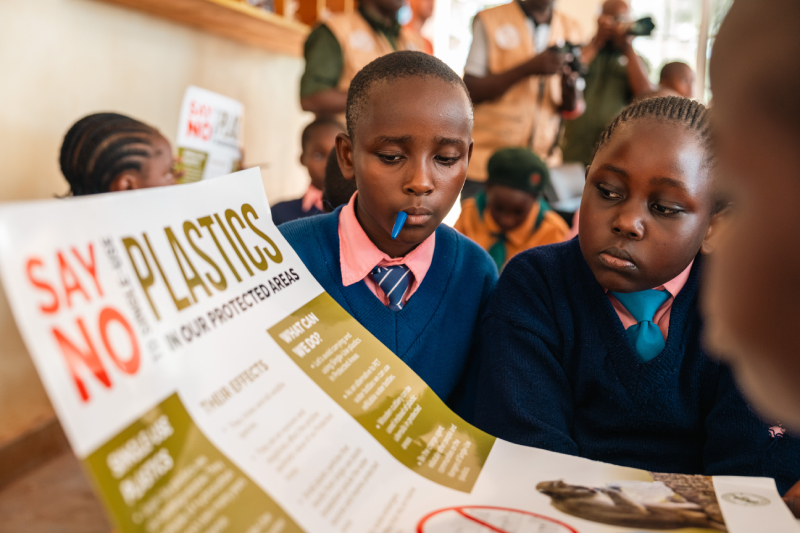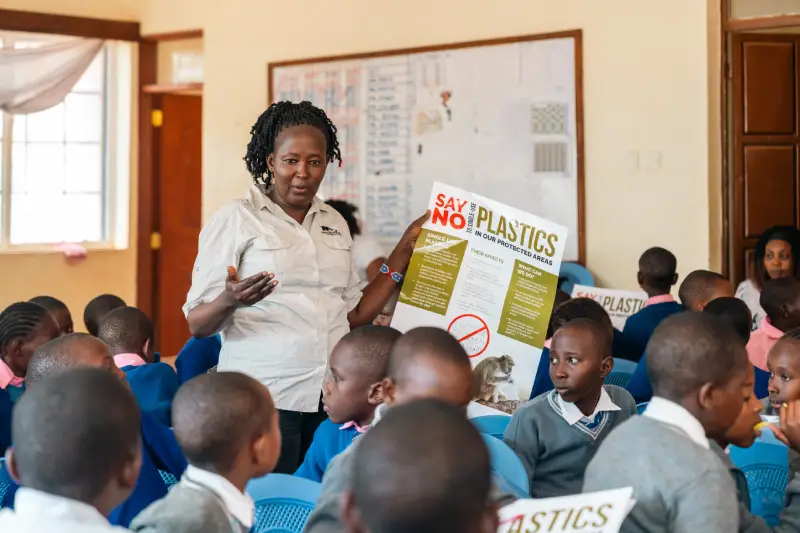Empowering Young Conservationists in Kenya's Tsavo Landscape

Food web demonstration at Kikwasuni Comprehensive School, Makueni County, Kenya.
Twelve-year-old Faith Mwikali, a sixth grader at Kikwasuni Comprehensive School in Makueni County, lives just 10 kilometers from Tsavo West National Park. Growing up near one of Kenya’s largest wildlife sanctuaries, she developed a fascination with wildlife, especially the zebras, whose unique patterns captivated her from an early age.
Driven by her love for nature, Mwikali joined her school’s wildlife club in 2021, eager to learn more about conservation. “I dream of a future where my surroundings are filled with beautiful big trees,” she says. “I especially love the neem tree for its medicinal properties and the shade it provides during the harsh sun.”
Through the wildlife club, Mwikali has gained hands-on skills, including how to protect young trees with thorny barriers and conserve water by covering the soil with grass—essential techniques in their dry, fragile ecosystem.
Earlier this year, the African Wildlife Foundation (AWF), in partnership with the Wildlife Clubs of Kenya (WCK), launched a four-year project in the Tsavo Landscape. The goal is to create a generation of young conservationists like Mwikali by equipping them with the knowledge and skills to tackle environmental challenges head-on.
As part of the project, AWF and WCK organized a two-week initiative, to distribute conservation education materials—including posters, teacher guides, and animated videos—to 31 primary schools near Tsavo East and West National Parks.
Through mobile van visits, the program reached approximately 9,000 students, aged 7 to 15, bringing conservation lessons directly to the schools. These sessions covered crucial topics such as climate change, biodiversity loss, charcoal burning, and plastic pollution. The use of conservation songs and games made the lessons more engaging, connecting with the students on a deeper level.

Students at Mtito Andei Primary School going through an informative poster on the effects of plastic pollution.
Mwikali especially enjoyed learning about ecosystems. “The food web activity showed me how everything in nature is connected, from tiny dung beetles, which help break down waste, to the air and soil we depend on,” she explains.
Bitah Frankline Ngina, an English teacher and wildlife club patron at Kikwasuni Comprehensive School, praised her students’ dedication to conservation. Despite the prolonged drought, her students bring water from home twice a week to care for the trees they have planted—an inspiring commitment to protecting their environment.
Ngina, who helped establish the wildlife club in 2021, organizes debates and student exchanges with other schools to foster a positive attitude toward wildlife and nature. "I’m grateful to AWF and WCK for the resources and support they've provided. I look forward to strengthening our wildlife club and further deepening our students' connection to conservation," she says.
This AWF-WCK project focuses on three key pillars that place the learner at the center namely: School Management Committees to sustain school projects, Parent-Teacher Associations to involve parents and the community, and Wildlife Club Patrons like Ngina, who provide ongoing support and guidance.
Why the Tsavo Landscape Matters
The Tsavo Landscape is Kenya’s largest conservation area, covering 22,000 square kilometers across Tsavo East and West National Parks. This region is home to critical wildlife, including nearly a fifth of Kenya’s black rhinos and over a third of its elephants.
But this richly biodiverse area is under threat. As wildlife stray outside park boundaries in search of food and water, human-wildlife conflicts are escalating. Habitat loss, combined with prolonged droughts, increases these tensions, leading to crop destruction and straining local livelihoods.
“These conflicts cause the rural youth and children in the Tsavo landscape, who represent the majority of the area's population, to perceive wildlife as a burden rather than an asset,” says Ben Akatch, a Mobile Education Officer with WCK. “This perception undermines conservation efforts.”
The surge in poaching and illegal bushmeat hunting, driven by unemployment and poverty, also points to the need for urgent educational initiatives. By targeting youth, AWF and WCK aim to shift perspectives and promote peaceful coexistence, reframing wildlife as an asset rather than a threat.

Margaret Mereyian, AWF's Senior Officer of the Conservation Education Program, engages students at Mtito Andei Primary School.
Margaret Mereyian, Senior Officer of AWF’s Conservation Education Program, emphasizes the importance of reaching young minds early.
“Introducing children to conservation at an early age fosters a lifelong connection to nature. The students then take what they have learned back to their homes and communities, spreading the impact even further.”
With continued financial support from Bob King and Emmy King, the AWF-WCK conservation awareness project hopes to spark a movement of young conservationists in Kenya—and eventually across Africa, where 40% of the population is 15 or younger, and 70% of sub-Saharan Africa is under 30.
By equipping the next generation with the tools and knowledge for conservation, AWF is laying the groundwork for future leaders who will protect Africa’s wildlife and ecosystems for generations to come.